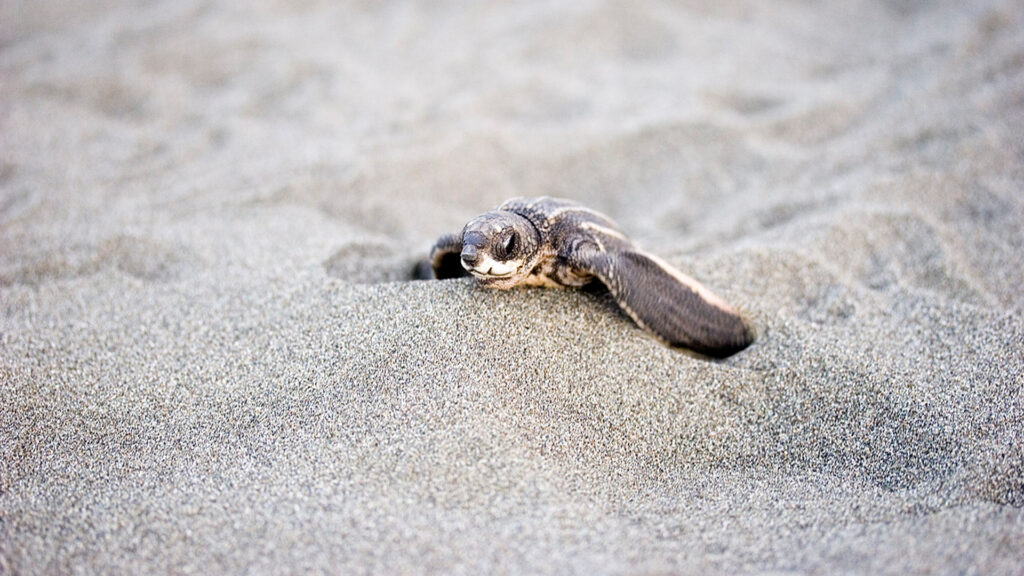By Gisele Galoustian, Florida Atlantic University
One of the most unique of all sea turtle species, the leatherback (Dermochelys coriacea), is distinguished by its smooth, “leathery” looking carapace or shell. Listed as vulnerable, this species is experiencing population declines from natural and anthropogenic threats – including climate change.
Environmental conditions affect sea turtles’ reproductive success inside the nest. Increasing sand temperatures can affect embryonic development, which can lead to decreased hatching success and hatchling performance. Hatchlings need to be in good physical shape to crawl from the nest to the water to avoid being preyed upon by seabirds, raccoons and other predators.
A Florida Atlantic University study is the first to examine the effects of incubation temperature on leatherback hatchling performance in the United States. Studies on nest temperatures and hatchling performance to date have focused primarily on green and loggerhead sea turtles.
Results, published in the journal Endangered Species Research, showed hatchling morphology, performance and nest success were all influenced by nest temperature. Mid- and late-season hatchling masses differed significantly from each other, where mid-season hatchlings weighed more.

For the study, temperature data loggers were placed in 13 leatherback turtle nests along 9.6 kilometers of coastline in Juno Beach on the day they were laid during the early, middle and late South Florida nesting seasons beginning in March and ending in June. Researchers looked at the relationship between nest incubation temperatures and hatching success, emergence success, hatchling morphology and locomotor performance.
Upon emergence, hatchlings were tested for righting ability (flipping over when placed on their back) and crawling speeds. To evaluate hatchling morphology, researchers used digital calipers to measure carapace length and width, body depth and flipper length. Body mass was determined using a digital scale. They also identified the overall mean incubation temperature and the maximum temperature for each nest.
Nests with lower temperatures produced longer hatchlings; the highest nest temperatures produced hatchlings with thicker body depths. Flipper length also correlated with temperature. Hatchlings from the highest nest temperatures had shorter flippers compared to hatchlings from mid-season nests that had longer flippers.
Incubation temperatures also affected hatchling performance. Righting response scores were significantly lower in hatchlings from late season, hotter nests. Hatchlings that were smaller and/or had a larger body depth struggled to right themselves. However, 30% of all 119 of the hatchlings tested across the season could not right themselves even one time.
Researchers did not find a correlation between incubation temperature and crawling, nor between crawling speed and hatchling size. Crawling speed did not significantly differ between early, mid and late nests.
“Interestingly, locomotor performance did not show the same correlations with temperature as hatching and emergence success, indicating hatchlings can be good performers even if they come from nests with poor hatching and emergence success,” said Sarah Milton, Ph.D., senior author and chair and professor, Department of Biological Sciences within FAU’s Charles E. Schmidt College of Science. “The leatherback hatchlings crawled at similar speeds, regardless of incubation mean or maximum temperature, which suggests there are other factors influencing performance. One factor that may influence terrestrial performance is their overall body morphology compared to the other species.”
Findings showed hatching and emergence success correlated with temperature, where the mid-season nests were the most successful. Nests incubating at hotter temperatures also had a shorter incubation period, which means embryo developmental time is reduced, and hatchlings are unable to convert as much of the yolk mass to body tissue growth. The leatherback turtle nests in this study had an overall lower hatching success (45%) than loggerhead (73%) and green sea turtles (70%).
“There could be a temperature ‘sweet spot’ for incubation since the mid-season nests had both higher hatching and emergence success and better hatchling physical performance,” said Milton.
Mean nest temperatures ranged from 29 degrees Celsius (84 degrees Fahrenheit) to 32.5 degrees Celsius (90.5 degrees Fahrenheit) and were significantly higher in the mid- and late season compared to early season nests.
“While leatherback turtle nests are laid in the cooler months in South Florida and are deeper than nests of other species, temperatures can still rise surprisingly high,” said Milton. “Increasing temperatures due to climate change poses a significant threat to a species that already has lower nest success than other species that share the same nesting beaches.”
Study co-author is Heather A. Seaman, an FAU graduate student pursuing her Ph.D., under Milton’s direction in the Department of Biological Sciences.
Sign up for The Invading Sea newsletter by visiting here. If you are interested in submitting an opinion piece to The Invading Sea, email Editor Nathan Crabbe at nc*****@*au.edu.



